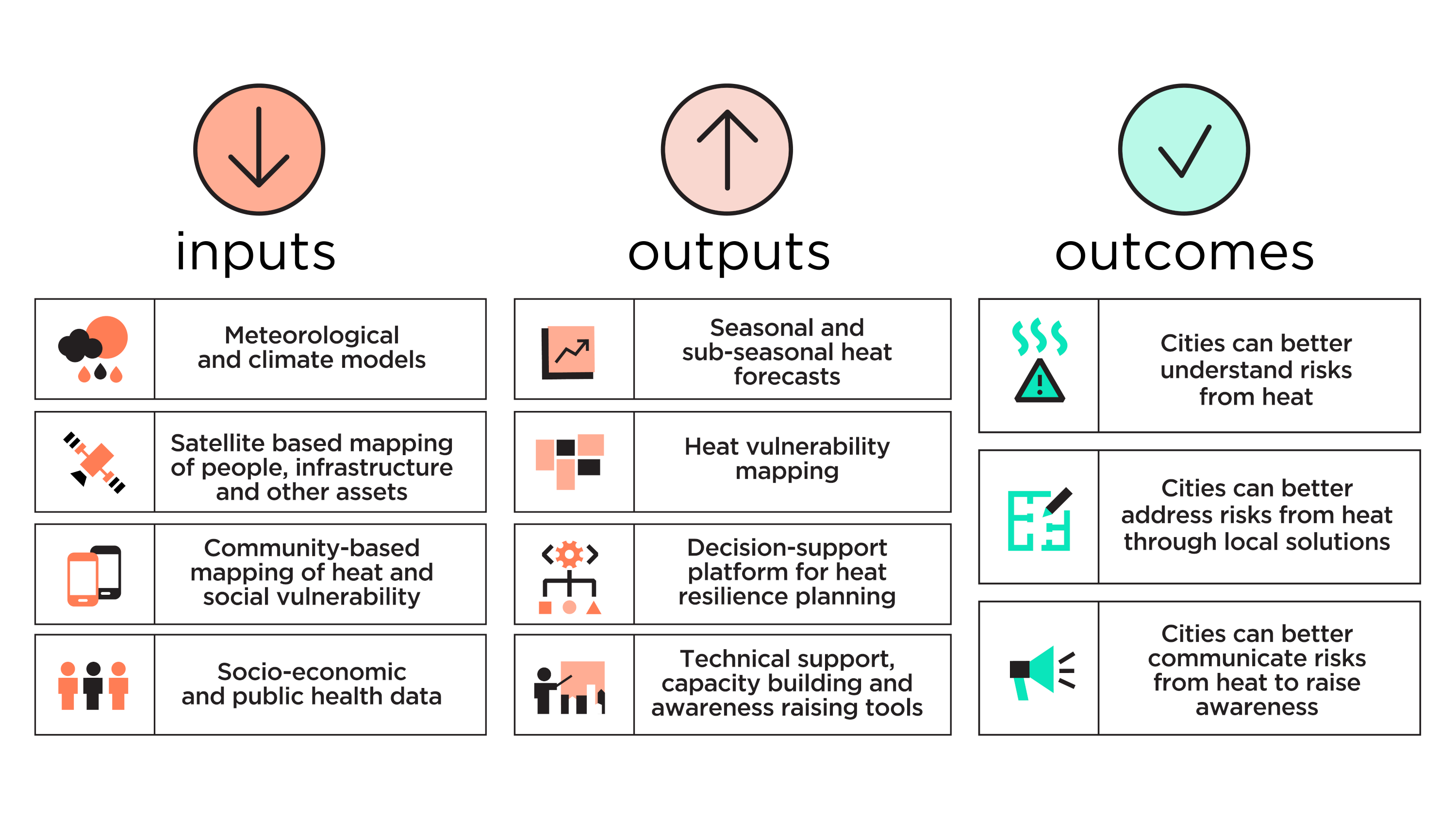About
GEO is joining forces with partners around the world to develop the Global Heat Resilience Service, aiming to help every city understand the dangers of extreme heat. With this transformative service, cities will be able to access valuable data, information, and insight to develop better plans for managing extreme heat events, protect people’s health, and reduce the impact on local economies.
THE IMPACT OF HEAT ON HEALTH AND SOCIETY
Hot days and extreme heat events are becoming more intense and more frequent. Cities and urban areas are particularly affected due to an Urban Heat Island effect that can increase temperatures by up to 20 degrees Fahrenheit.
This extreme heat poses a serious health threat, causing about 500,000 extra deaths a year globally, and is particularly dangerous for vulnerable groups like the elderly, pregnant women, young children, and people with chronic health conditions.
Extreme heat can also worsen air quality and increase disease spread, workplace injuries, and mental health issues, as well as disrupting key services like energy and transportation. Economically, heat stress could cost the global economy $2.4 trillion by 2030, with poorer communities and countries suffering the most. Urban areas in developing regions face the greatest challenges due to limited resources to combat these climate risks.
THE NEED FOR GLOBAL HEAT RESILIENCE
Death and illness can be prevented with tailored strategies and plans, such as investing in green spaces in vulnerable areas, and by improving early warning systems, as supported by the UN’s Early Warning for All initiative.
Cities often lack the resources and data necessary to develop effective heat resilience strategies. The Global Heat Resilience Service aims to address this gap. It's not just about providing early warnings; it's about equipping cities with the tools and information needed for comprehensive heat risk management. This includes understanding local climate patterns, health impacts, infrastructure vulnerabilities, and socioeconomic factors.
By harnessing advanced technology, cloud computing, and AI, the service will guide cities in identifying vulnerable populations and planning effective responses, thus offering a proactive solution to a growing global challenge.

It will be more cost-effective to prepare cities for extreme heat now than to deal with the impacts later. Currently only around 7-8% of global urban climate financing needs are being met, with far less still flowing to urban areas in the global south. A key barrier to accessing this climate finance is a lack of appropriate data and information with which to develop feasible plans and projects to mitigate risks.
The Global Heat Resilience Service aims to fill these gaps. Using the latest digital tools and leveraging the power of cloud computing and Artificial Intelligence, the service will help cities to understand when and where extreme heat events will occur, who will be most vulnerable, and what actions can be taken to manage risks.
THE GLOBAL HEAT RESILIENCE SERVICE
The Global Heat Resilience Service will provide essential, city-specific information to help improve public health, the economy, and urban development in response to extreme heat, now and into the future. Using a mix of data sources, including satellites, field measurements, local surveys, and geospatial data, the service will help cities to better understand and prepare for heat-related risks.
This service will offer trusted, free, and open data specific enough to pinpoint variations in heat risks from street to street, neighborhood to neighborhood. Cities will be able to integrate their own data, enabling them to make informed decisions before and during extreme heat events. The insights from this resource will assist and guide city leaders in creating policies, plans, and investments to reduce heat-related health issues and economic impacts.
Citizen science and data collection initiatives will empower communities, particularly young people, to actively contribute to developing knowledge on heat vulnerability in their cities. This includes spreading awareness through educational programs in schools and colleges, creating opportunities to boost local technology sectors, and developing data-driven apps through hackathons.

WHO WILL USE THE SERVICE?
-
City and regional planners to develop targeted adaptation and mitigation plans that help mitigate the impact of heat in the urban environment, through design and construction of buildings and infrastructure.
-
Public health authorities to communicate risks and mitigation actions to reduce health impacts.
-
Health care providers and emergency services to prepare and respond to heat-related emergencies - preparing for increases in heat related illnesses and injuries.
-
Community members to understand the risks of heat waves and protect themselves and their families.
-
Private sector to develop products and services related to cooling and other risk reduction initiatives.
-
Governments to design policies to mitigate risk on populations and improve the efficacy of early warning systems, and mobilize finance for climate adaptation.
-
Insurance companies in designing appropriate insurance products to offset losses from heat.
-
Researchers who need access to data on heat waves and their health impacts to inform policy and research.
-
Non-Government Organisations to inform development and humanitarian projects in urban environments with local communities.
-
Intergovernmental agencies to inform policies and initiatives to support governments in adaptation and mitigation.
-
International conventions such as the UNFCCC to monitor the impacts of climate change on public health and inform activities.

WORK PLAN
GEO and the World Meteorological Organization have developed the project concept. A project team comprised of scientific and policy experts on the use of Earth observations for climate change, urbanization, and health will facilitate the co-design of the service in partnership with representatives of health, meteorological and emergency management agencies, city and local governments and their communities, statistical and mapping agencies, experts in data analytics, software development and user experience design.
The key stages of the project will be project design (to be completed by early 2024), EO data collection and processing, pilot city-partnerships and, testing, interface/platform and service development, and scale-up, implementation and monitoring. The project will require funding at each stage to cover costs including personnel, data acquisition and analysis, software development and hardware infrastructure, operations and maintenance, capacity building, communications, and awareness raising activities. The Service will be a key input for the delivery of a Global Early Warning System for All to be developed by 2027 as part of a commitment by the UN Secretary General.
We are seeking partners to collaborate on the project. Collaboration will be sought throughout design and implementation phases with those who can provide the following support:
-
Scientific/Technical (Earth observation methods tools, data management)
-
Policy & Advocacy
-
Stakeholder & Community / Youth Engagement
-
Capacity Building
-
Funding and Investment


